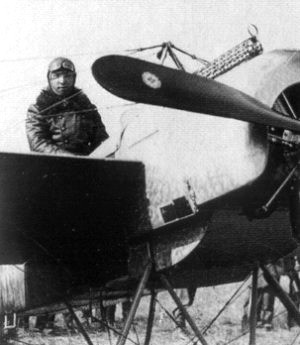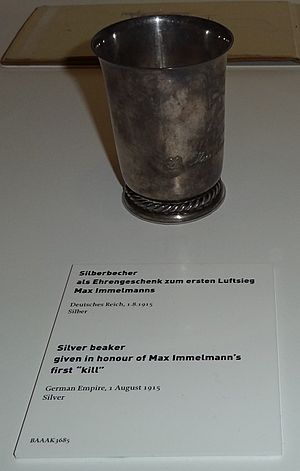Max Immelmann facts for kids
Quick facts for kids
Max Immelmann
|
|
|---|---|

Max Immelmann in 1916
|
|
| Nickname(s) | Der Adler von Lille (The Eagle of Lille) |
| Born | 21 September 1890 Dresden, Kingdom of Saxony, German Empire |
| Died | 18 June 1916 (aged 25) Lens, Pas-de-Calais, France |
| Allegiance | |
| Service/ |
|
| Years of service |
|
| Rank | Oberleutnant |
| Unit | Eisenbahnregiment Nr. 2, Eisenbahnregiment Nr. 1, FEA 2, FFA 10, FAA 62 |
| Awards |
|
Max Immelmann (born September 21, 1890 – died June 18, 1916) was a famous German pilot during World War I. He was the first German "flying ace", which means he shot down many enemy airplanes. He was also a pioneer in how fighter planes were used.
Max Immelmann was one of the first pilots to get Germany's highest military award, the Pour le Mérite. People often called this medal the "Blue Max" because of him. He is also known for a flying move called the Immelmann turn, which is still used today. He achieved 15 confirmed victories in the air.
Contents
Early Life and Training
Max Immelmann was born in Dresden, Germany, on September 21, 1890. His father was a factory owner who passed away when Max was young. In 1905, Max went to the Dresden Cadet School, which was a military school.
In 1911, he joined a railway regiment in the army. However, he left the army in 1912 to study engineering. When World War I began in 1914, he rejoined the army. Soon after, he transferred to the air force, which was called Die Fliegertruppe des Deutschen Kaiserreiches. He started his pilot training in November 1914.
Becoming a Fighter Pilot
Max Immelmann first flew two-seater planes, but he didn't have much success in combat. On June 3, 1915, his plane was shot down by a French pilot. Luckily, he landed safely behind German lines and was given the Iron Cross, Second Class, for saving his aircraft.
Later, Immelmann received a new type of plane called the Fokker Eindecker fighters. This plane was special because it had a machine gun that could fire through the spinning propeller without hitting it. This was a big advantage!
On August 1, 1915, Immelmann got his first confirmed air victory using his Fokker Eindecker. He shot down a British plane. The pilot, Lieutenant William Reid, was wounded but survived. Immelmann landed nearby, helped Reid, and took him as a prisoner.
Like a hawk, I dived... and fired my machine gun. For a moment, I believed I would fly right into him. I had fired about 60 shots when my gun jammed. That was awkward, for to clear the jam I needed both hands – I had to fly completely without hands...
Max Immelmann quickly became one of Germany's top fighter pilots. He earned the nickname The Eagle of Lille (Der Adler von Lille) because he was in charge of defending the city of Lille from air attacks.
The "Blue Max" Award
Immelmann and another famous pilot, Oswald Boelcke, were always competing for the most victories. On January 12, 1916, after his eighth victory, Immelmann became the first pilot to receive the Pour le Mérite. This was Germany's highest military honor. It became known as the "Blue Max" in his honor. The German Emperor, Kaiser Wilhelm II, personally presented him with the medal. Oswald Boelcke received his medal at the same time.
Immelmann continued to fly and fight. He faced new, improved British aircraft, which made his job harder. On May 31, his plane's gun system broke during a fight, causing damage to his propeller. He managed to land safely, but it showed how dangerous flying could be.
His Final Flight
On June 18, 1916, Immelmann led a group of four Fokker planes to find eight British planes. After a long fight, Immelmann shot down one enemy plane. This was his 16th victory claim.
Later that evening, Immelmann met more British planes. He shot down another one, but then his own plane was hit. Many Germans believed he was invincible. Some thought his plane's gun system failed again, causing him to shoot off his own propeller. Others, including the British pilots, said they shot him down.
His plane broke apart in the air, and he crashed. Max Immelmann was given a state funeral in his hometown of Dresden.
Legacy and Recognition
Max Immelmann is remembered as a brave and skilled pilot. The German air force today has named one of its squadrons, AG-51, the "Immelmann Squadron" in his honor.
Military Career Milestones
- 1905–1912: Cadet at Dresden Cadet School.
- 1911: Joined the 2nd Railway Regiment.
- 1914: Began pilot training in the Imperial German Flying Corps.
- 1915: Assigned to Flying Section 10, then Flying Section 62.
- July 1915: Became a Second Lieutenant in the Royal Saxony Army Reserves.
- April 1916: Became a Full First Lieutenant in the Royal Saxon Army.
Awards and Medals
Max Immelmann received many awards for his bravery and skill:
- Pour le Mérite: Germany's highest military honor, received after his eighth victory.
- Iron Cross: Awarded in both First and Second Class for his actions in combat.
- Royal House Order of Hohenzollern: A knight's cross with swords.
- Military Order of St. Henry: A high award from Saxony, received after his 12th and 13th victories.
- Albert Order: Another award from Saxony.
- Hanseatic Cross: From Hamburg, for defending the city.
- Other awards from Bavaria, Anhalt, and the Ottoman Empire.
The Fokker Eindecker Plane
Max Immelmann is strongly linked to the Fokker Eindecker, which was Germany's first true fighter aircraft. It was the first plane to have a machine gun that could fire safely through the propeller. Immelmann, along with Oswald Boelcke, used these planes to great effect, causing many problems for British and French pilots in 1915. This period was known as the Fokker Scourge.
Immelmann initially shared a plane with Boelcke. Later, he received his own Eindecker, which was powered by an 80-horsepower engine. This plane helped him achieve his first five victories.
The Immelmann Turn
The "Immelmann turn" is a famous flying maneuver. There are two main ideas about what it means:
- Modern Immelmann Turn: This is a half-loop followed by a half-roll. It lets a pilot quickly change direction. However, it might have been too difficult for the early planes of World War I.
- World War I Immelmann Turn: During the war, an "Immelmann turn" was likely a sharp turn after climbing steeply, almost to a stop, followed by a fast dive. Max Immelmann might have invented this move or used it often in battles.
Images for kids
See also
 In Spanish: Max Immelmann para niños
In Spanish: Max Immelmann para niños
- Aerobatics
- Flying ace
- Fokker Eindecker
- Fokker Scourge
- Oswald Boelcke
- Pour le Mérite
- Immelmann turn
- Kurt Wintgens






